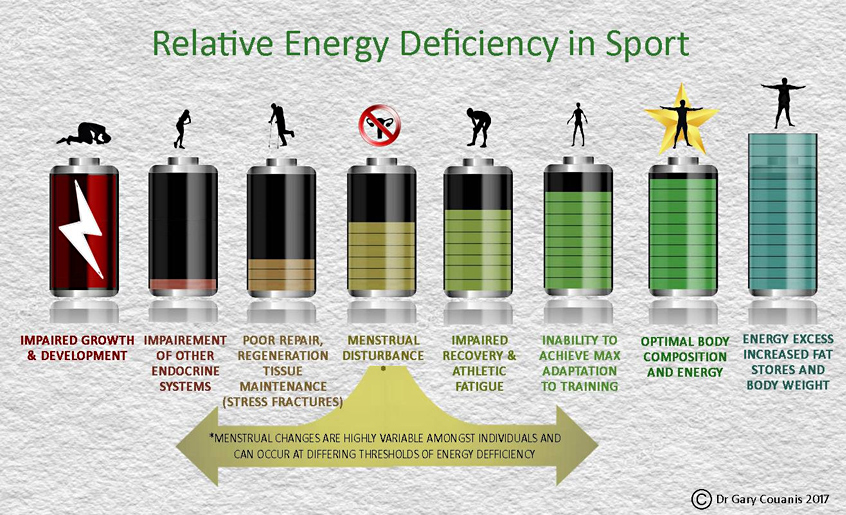Relative Energy Deficiency in Sport (RED-S)
What is relative energy deficiency in sport?
Relative Energy Deficiency in Sport (RED-S) is where the body is not taking in enough energy to meet the demands placed on it by the amount of exercise being performed. This is called Reduced Energy Availability. This leads not only to insufficient energy for peak sports performance, but also to insufficient energy to maintain optimal health, with a range of body functions being affected.
Put simply: Energy Expenditure > Energy Intake = decreased Energy Availability.
RED-S was formerly called “Female Athlete Triad” (disordered eating, menstrual disturbance, low bone density). The name has been revised to reflect that it occurs in men also, and impacts on more than the 3 original areas of health originally described.

What are the symptoms of relative energy deficiency in sport?
The event that leads to a diagnosis of RED-S in an athlete is often a stress fracture. You can read more about stress fractures here. It can also commonly be identified by reduced performance, excessive fatigue and missed menstrual periods.
Other symptoms of RED-S include:
- Weight loss/underweight
- Periods stopping/becoming irregular
- Recurrent illnesses e.g. colds and flu’s
- Decreased sports performance
- Mood Changes
- Delayed/disordered growth/development (children and teenagers)
- Iron deficiency
- Severe RED-S can affect the heart.
Why do I miss my period when I train?
When there is limited Energy Availability (“spare energy”), the hypothalamus and pituitary (glands that regulate many of our body’s hormones) reduce or stop producing certain hormones, including the ones that regulate the female menstrual cycle (ovulation and periods). Although changes in menstruation are often the earliest sign of low energy availability in female athletes, it is not always the most reliable sign as different athletes can have vastly different thresholds at which their menstrual cycles are affected. Missed periods can be a warning sign that bone health and other aspects of health may also be at risk. It should be noted that there are other things that may affect menstruation other than RED-S (e.g. Polycystic Ovarian Syndrome). A sports doctor can help work this out if you train and have absent or irregular periods.
How does relative energy deficiency in sport affect sports performance??
RED-S negatively affects sports performance in a number of ways.
- Reduced energy availability to working muscles leads to a more rapid onset of fatigue.
- Muscle size and strength is often reduced due to a number of factors including neuromuscular (how the nervous system controls muscles) and cortisol (stress hormone) changes, and reduced testosterone (in both men and women). These decreases usually negate any benefits in “power to weight ratio” that the athlete may seek by chasing excessive leanness.
- Recovery is impaired. This impedes the body’s ability to supply enough energy for subsequent training sessions, increasing the risk of overtraining and chronic fatigue.
- Energy is required to adapt to training. If there is low energy availability, muscle and cardiovascular adaptation and growth can’t occur as effectively.
- Injury risk. If there is poor energy availability for repairing sprains, strains and bone-impact injuries, they can heal more slowly or develop into chronic injuries.
How does relative energy deficiency in sport affect injury risk?
Injury risk is increased due to impaired recovery from training, and impaired adaptation (the gradual strengthening due to exercise) of muscles, tendons and bones. Impaired coordination and concentration also increase injury risk. Stress fractures due to reduced bone density are common and can mean missing weeks or months of training
What are the long-term health risks in relative energy deficiency in sport?
Most of our bone density is formed during our teenage years. If there is reduced bone formation in adolescence or early adulthood, it can lead to long term problems with bone weakness and osteoporosis. Longer term health such as fertility can also be affected. The good news is that most of the health consequences from RED-S are reversible when picked up early. An athlete guided by an experienced medical team can expect to see improvements in their overall health and wellbeing and performance.
How is relative energy deficiency in sport treated?
Every athlete with RED-S is an individual, and so treatment is individualised based on each athlete’s symptoms (e.g. performance decrease, menstrual disturbance, recurrent infections, bone stress injury), sport, goals, and personal circumstances.
The key thing is addressing the mismatch between energy intake and energy expenditure. A sports dietician, a doctor who understands the condition and the demands of the athlete’s sport, the coach and the athlete work together to return the athlete to optimal health, and subsequently optimal performance.
Often athletes can worry about getting ‘fatter’ or ‘slower’ when energy availability is increased. This definitely does not have to be the case. Our expert Sport and Exercise Physicians understand the demands of elite and competitive sport and will help you with a focus on both health and performance.
What is the best diet for relative energy deficiency in sport?
There is no single best diet, and each athlete’s needs will be different depending on their sport, lifestyle and dietary preferences/requirements. In general, adequate calcium and Vitamin D intake to support bone health, and adequate energy and protein to support exercise and recovery are key factors.
Can relative energy deficiency in sport be treated without putting on weight?
We know from experience and research that below a certain extreme body weight for height, bone and hormonal health cannot be maintained. In these cases some weight gain will be necessary for health and performance. In many cases, improving energy availability can be achieved without gaining much weight. One of the effects of RED-S is to reduce resting metabolic rate, and so improving energy availability actually leads to increased resting metabolism.





















